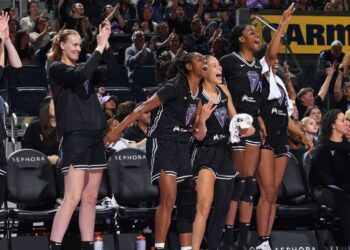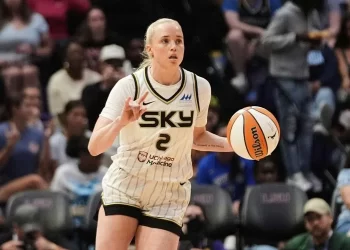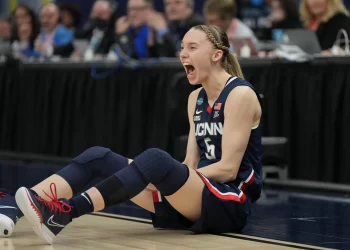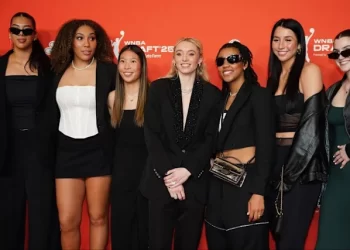By: Stephen PridGeon-Garner
Back on January 15th, the New York Liberty traded for 2021 WNBA MVP Jonquel Jones.
Jones is one of the most versatile and dynamic basketball players (in general) in the world and brings this level of skill in a 6-6 frame.
She’s an elite, three-level scorer, a more than capable passer, and a presence on the glass. While also doubling as no slouch in the slightest on the defensive end of the floor either.
She presents the ability to dribble coast to coast off of offensive rebounding, while eluding would-be defenders, or stop and pop after creating separation, all the while playing up to the level of the screen defensively, with the hand and foot speed to be disruptive in dictating away from the basket.

She’s a task to deal with for any opposing team.
Her now being with guard talents the likes of Sabrina Ionescu, as well as Marine Johannes, as well as the spacing they provide, makes for two pick-and-roll tandems that will leave the opposing team’s scouts up at night.
These two tandems will be virtually scheme-proof.
At Jonquel Jones’ introductory press conference, I asked the newest member of the Liberty how playing alongside creative pick-and-roll passers like Sabrina Ionescu and Marine Johannès could help her game. https://t.co/Az7CukcgL0 pic.twitter.com/3hkJtxCUOC
— Myles (@MylesEhrlich) January 21, 2023
Hat tip to my man, Myles, for the great question there.
Let’s zoom in on each tandem, individually.
Sabrina and Jonquel
We’ve spoken about the all-encompassing talents of Jonquel Jones already.
In Sabrina, there exists one of the most well-rounded guards on the offensive end in the W.

The score-first nature of Ionescu presents craftiness, shake with shiftiness in her handle, savant-level patience and pace changes, ability to maneuver downhill, ability to shoot off the dribble, and ability to shoot off the dribble *from range*.
She’s a threat as soon as she crosses the halfcourt line, so naturally, defenders are tasked with extending pressure well past the base of any defensive shell.
In that, will be provided a dynamic in spacing that Jonquel Jones has never had.
Jones is more than capable in pick-and-pop as well as pick-and-roll, and doing so with *this* dynamic in spacing will reap benefits she’s never seen nor felt on the W stage.
(Also, as a side note, Jonquel’s post-ups and mid-post touches in isolation can’t be remedied by sending doubles from the passer, because, more often than not, said passer will be Ionescu. Also, Jonquel has ample ability to play make herself and play off of the ever-present advantage that her scoring presents).
You can’t play drop coverage against Sabrina because of her threat to pull up from range, you can’t play at the level or put two to the ball on Ionescu when Jones is screening because that allows Jonquel to play 4v3 underneath the screen off the short-roll, and you can’t switch because that’ll leave a smaller framed guard on Jonquel, or leave Sabrina with a mismatch to exploit.
That’s going to be a Rubix cube of sorts to solve for the W, as we’ll see teams rolling the dice on multiple coverages, essentially choosing what dynamic of their game they’ll concede or render their defense helpless to.
This will be especially impactful come postseason play, as teams have banked on Ionescu’s frontcourt teammates to play make, typically putting two to the ball whenever she initiates pick-and-roll, then making her work to get the ball back after that.
With Jones now in the fold, that’s not a viable option anymore, as there’s really no viable option.
Aside from maybe Chelsea Gray pull-ups, there will be no more daunting late-clock situation to be tasked with defending, regardless of what may have happened in earlier portions of a possession.
Marine and Jonquel
In Marine, there is a craft-galore playmaking extraordinaire.

There isn’t a pass she doesn’t have in her catalog, and she can probably deliver any given pass in more than one (or two, or three) different manners.
She has an unparalleled level of unpredictability that keeps all five defenders on the floor on their toes, as the slightest point of being out of position could have viral-worthy ramifications, in addition to being scored on.
Add that to the range she brings to the fold off the dribble, and the fact that there isn’t a shot she’s met that she isn’t comfortable taking (be it off movement or one leg), and her ability to maneuver downhill as well, and she makes for the perfect storm to pick a defense apart.
Add Jonquel to her dynamic in pick play, and you have yet another potentially scheme-proof tandem that’ll be near impossible to solve.
The same issues presented in schemes with Sabrina-Jonquel, are present between Marine-Jonquel as well.
If anything, with her passing catalog and levels of unpredictability, they may be even exacerbated in many ways.
Point is, when looking at how each of these three has been defended in recent memory and adding the context of them sharing the floor together, it becomes increasingly obvious the demand they’ll have in teams.
Now, of course, Johannès is still pending as she’s received a qualifying offer from the Liberty, however, for this exercise, it was appropriate and irresistible to ponder upon what a defense will be tasked with in terms of attempting to defend these tandems.
In Conclusion
If I were in charge of an opposing defense, the first thing I’d be doing is saying my prayers thoroughly the night before.
After that, it’d all depend on the scenario with both of those tandems.
I’d essentially play no middles, applying extra pressure to funnel actions away from the middle third of the floor. Using the sideline as an extra defender, the “icing” all actions to the point where her dribble is terminated.
As that occurs on-ball, with Sabrina, whether Jones pops or rolls, I’d have (very) early help pinched in from the weak side to “tag” with physicality.
Essentially, betting on keeping her to her left hand as often as possible to make the requisite passes to beat the scheme tougher with her off-hand, though she’s again more than capable of breaking it and forcing me to try something else (which is inevitable because a steady diet of any scheme will be beaten after two to three possessions if it looks the exact same).
With Johannès, because she’s such a creative passer, I’d rather not put my defense in rotation and render an advantage possible of being found and then exploited by her playmaking brilliance.
So, I’d go with switching and then doubling after two or three dribbles with her. In hopes that A.) I have the versatility with my frontcourt defenders to contain her in space without fouling, and B.) Keep her at bay with wonder if and when a double may be coming.
Neither of these two is sure to work, as Joquel has a height advantage in most scenarios, so a pass could be thrown over the top for her to catch, then play off in space after the extra attention given to the two guards.
In the same vein, for Sabrina, if they keep her in the middle third to counter my outer-third aggressiveness, that’ll leave us vulnerable to high-low passing with, say, Stefanie Dolson, who’s a solid connector.
In the case of Johannès, if she’s in scoring mode at the right time and picks her spots appropriately, especially with how she thinks outside of the box, that’ll force me to try another coverage as well.
The one thing I’m sure of is, if you sit back on your heels in a run-of-the-mill drop coverage, they will score in abundance and overflow. You absolutely have to apply a dictating style of defense to these tandems.
It’ll be fun to track just what different personnel groups from opponents do, what works, which teams have the requisite blend of personnel and scheme to neutralize these tandems, and also see what flat-out doesn’t work.
What is known is that, among the best or most dynamic pick-and-roll tandems across the W moving forward, these two pairings are sure to be at or near the top, and will be a staple in the foundation of the New York Liberty’s attack.
How would you go about attempting to stifle either of these two tandems?


 NFL
NFL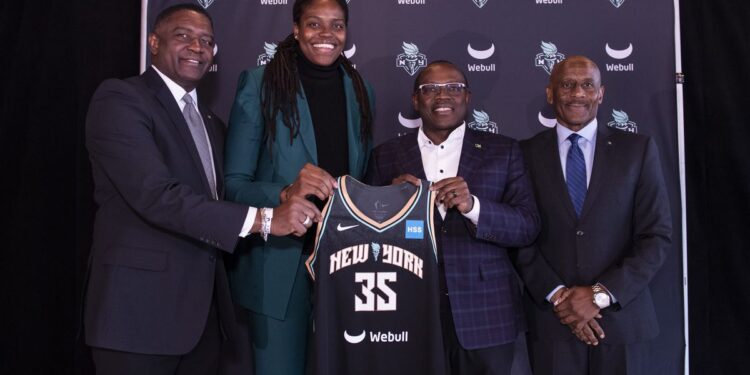
 @StayTrueSdot3
@StayTrueSdot3 